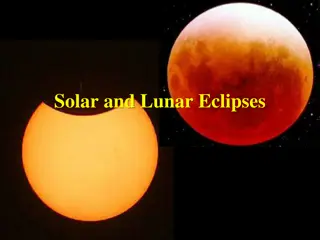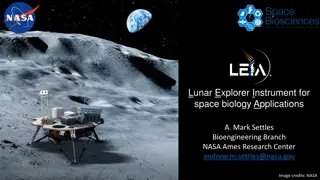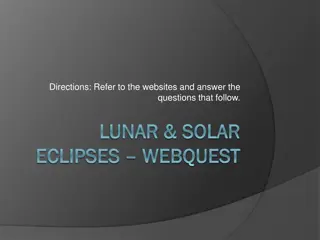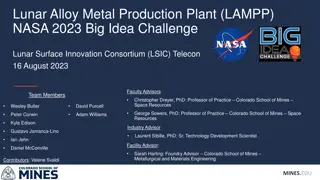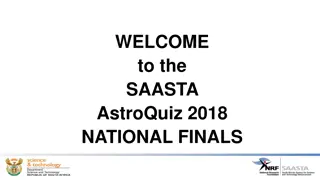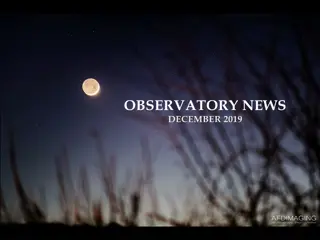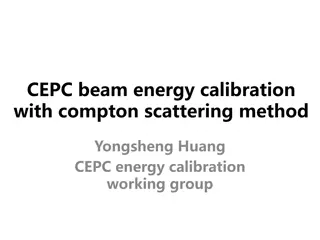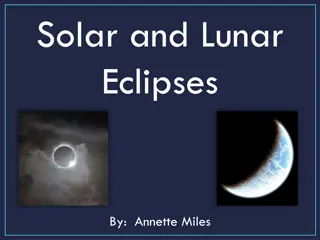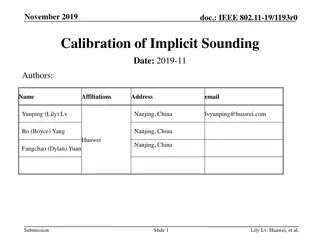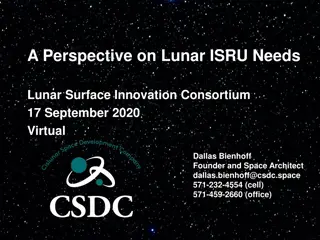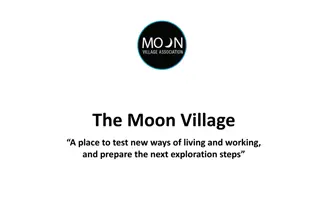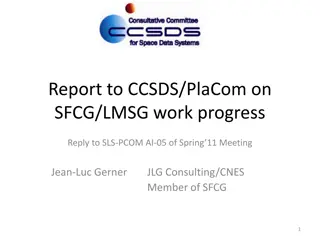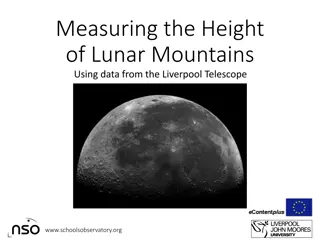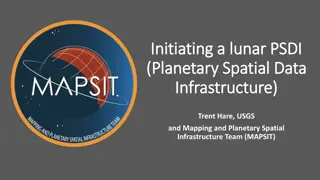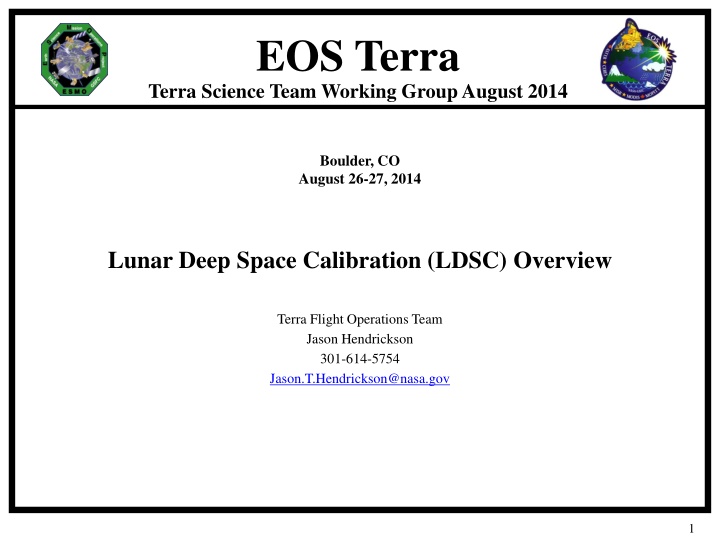
Lunar Deep Space Calibration Overview for Terra Mission
Explore the detailed overview of Lunar Deep Space Calibration (LDSC) for the Terra Mission, focusing on calibration maneuvers, past missions, and instrument benefits. Engage with the latest advancements in space science and technology.
Download Presentation

Please find below an Image/Link to download the presentation.
The content on the website is provided AS IS for your information and personal use only. It may not be sold, licensed, or shared on other websites without obtaining consent from the author. If you encounter any issues during the download, it is possible that the publisher has removed the file from their server.
You are allowed to download the files provided on this website for personal or commercial use, subject to the condition that they are used lawfully. All files are the property of their respective owners.
The content on the website is provided AS IS for your information and personal use only. It may not be sold, licensed, or shared on other websites without obtaining consent from the author.
E N D
Presentation Transcript
EOS Terra Terra Science Team Working Group August 2014 Boulder, CO August 26-27, 2014 Lunar Deep Space Calibration (LDSC) Overview Terra Flight Operations Team Jason Hendrickson 301-614-5754 Jason.T.Hendrickson@nasa.gov 1
Lunar Deep Space Calibration Overview In August 2013, the ASTER Team requested the Terra FOT to review the previous Deep Space Calibrations (DSC) in 2003 and determine steps for future DSC near End of Mission (EOM) ASTER Science team made an official request with the Terra Project Scientist A DSC maneuver is an accelerated 240 degree pitch-over (360 relative to local horizon) during S/C night which provides the science instruments calibration opportunities using the cold background of deep space and an option for a lunar viewing Two previous DSC maneuvers were executed in 2003 The DOY 085 (3/26/03) maneuver was only a deep space calibration (DSC) The DOY 104 (4/14/03) maneuver was both deep space and a lunar calibration (LDSC) A LDSC near Terra EOM would provide the Terra instruments observations that can be compared against the LDSC in 2003 to calibrate science observations over the life of the mission 2
DSC Concept Diagram 7 6 5 2 3 4 1 Blue block on S/C is instrument deck 3
LDSC Concept Description ID Method of Execution Pitch (deg) ECI MET Event Description OCS Real-time Real-time Stored command Stored command Stored command - 02:20:00 - 02:15:00 - 00:12:00 - 00:00:30 00:00:00 00:03:02 00:05:00 00:07:40 00:08:14 00:11:00 00:18:05 00:32:51 00:35:54 00:36:24 00:38:00 Remove wheels bias +40.5 N-m-s pitch momentum bias Disable all high fidelity filters Enable DSC FDIR Maneuver start Constant rate -40.5 N-m-s pitch momentum bias +Z axis at Earth limb Eclipse entrance Nadir cameras view Moon Maneuver mid point Deceleration Maneuver end Return to Normal mode FDIR Remove pitch momentum bias N/A 1 0 6 0 17 Real-time 2 3 4 5 6 7 40 44 64 116 224 240 67 73 104 180 340 360 Stored command Store Command Real-time N/A 4
DSC Concept Diagram (Animation) 7 6 5 2 3 4 1 Blue block on S/C is instrument deck 5
Previous LDSC Images MODIS ASTER MISR 6
Instrument Benefits ASTER, MODIS and MISR will get most benefit from a Lunar Deep Space Calibration Provides another lunar observation with earth view optics to measure changes since the 2003 calibration CERES will get most benefit from dark Deep Space Calibration Possible for CERES to get Deep Space observations during LDSC depending on timing of lunar in-view period Little benefit is expected for MOPITT from a Lunar Deep Space Calibration 7
Constraints There are two primary considerations with scheduling DSC maneuvers: 1) Availability of continuous communications coverage (Optional) High Gain antenna (HGA) in view of TDRS must begin at the southern hemisphere and last the entire eclipse FOT must account for HGA while the S/C pitch is changing to ensure it is not blocked by the solar array or other structures 2) For a good Lunar DSC observation The moon must be near Terra s orbit plane Executed ~2 days before full moon and lunar phase angle ~22.3 deg ASTER lunar view must start no earlier than 14705 sec and completed no later than 4539 sec from the time the Moon crosses the orbit plane (Based on 2003 parameters) ASTER must see the Moon within 20 minutes of maneuver MISR requested the Moon to pass by at a uniform rate through the field of view of all 9 cameras Several LDSC observation parameters are based on orbit plane procession This will vary depending on the performance of the last Inclination maneuver As such LDSC planning will be difficult to finalize until after the preceding Inclination series is completed 8
Risks of LDSC Terra Routinely (monthly) does MODIS Roll calibrations only 1/12th the magnitude These slews are in the roll axis and are limited to -20 degrees due to safety considerations (defined prelaunch) The Lunar Deep Space Calibration will be a pitch of 240 degrees (360 degrees relative to the Earth) Should a major safing anomaly occur during the LDSC it is likely Terra would transition to Sun Point Safe Mode If Terra is off Nadir Pointing enough at time of safing Terra will not be able to acquire the earth and transition to Sun Pointing Terra has never operated Sun Point Safe Mode on orbit 9
Risk Mitigation Risk assessment was done prior to approval of the 2003 LDSC An updated risk assessment would likely proceed approval of an End of Mission LDSC Terra S/C Bus is still healthy GN&C Subsystem is still on all primary hardware with full functionality LDSC will be performed in Eclipse in order to avoid the risk of damaging sun exposure Terra FOT will perform multiple simulations of a LDSC prior to actual execution This will include Sun Pointing Safe Simulations 10
LDSC Opportunities 1/10/17 - 10/29/20 2017 2018 2019 2020 i yearMonDay 0 2017-01-10 20:39:36.6 1 2017-02-09 06:45:42.2 2 2017-03-10 18:11:57.2 3 2017-04-09 07:25:04.7 4 2017-05-08 22:01:52.5 5 2017-06-07 13:08:54.4 6 2017-07-07 04:07:30.0 7 2017-08-05 18:57:39.4 8 2017-09-04 09:49:55.3 9 2017-10-04 00:28:49.7 10 2017-11-02 14:12:53.4 11 2017-12-02 02:24:08.4 12 2017-12-31 13:05:23.4 Hr Mn sec i yearMonDay 13 2018-01-29 22:58:07.5 14 2018-02-28 08:48:45.0 15 2018-03-29 19:02:34.7 16 2018-04-28 05:42:25.3 17 2018-05-27 16:53:54.4 18 2018-06-26 05:03:02.8 19 2018-07-25 18:50:37.5 20 2018-08-24 10:38:26.2 21 2018-09-23 03:50:37.5 22 2018-10-22 20:57:11.2 23 2018-11-21 12:35:09.4 24 2018-12-21 02:20:37.5 Hr Mn sec i yearMonDay 25 2019-01-19 14:37:30.0 26 2019-02-18 01:48:16.9 27 2019-03-19 11:50:51.6 28 2019-04-17 20:36:47.8 29 2019-05-17 04:32:06.6 30 2019-06-15 12:44:17.8 31 2019-07-14 22:41:15.0 32 2019-08-13 11:32:34.7 33 2019-09-12 03:27:25.3 34 2019-10-11 21:18:16.9 35 2019-11-10 15:26:00.9 36 2019-12-10 08:48:02.8 Hr Mn sec i yearMonDay 37 2020-01-09 01:00:28.1 38 2020-02-07 15:41:29.1 39 2020-03-08 04:11:00.9 40 2020-04-06 13:59:31.9 41 2020-05-05 21:27:25.3 42 2020-06-04 03:49:55.3 43 2020-07-03 10:41:15.0 44 2020-08-01 19:28:35.6 45 2020-08-31 07:03:59.1 46 2020-09-29 21:29:31.9 47 2020-10-29 14:12:11.2 Hr Mn sec Opportunities based on Lunar phase angle of -22.5 degrees Does not include alignment with orbital plane (required) o Would need to take into account performance of IAM series preceding LDSC Does not include continuous HGA Comm. Coverage (optional) Times predictions will change due to propagation errors As we approach opportunity dates predictions will become more accurate and will be able to eliminate opportunities that do not align with orbital plane Credit to Hugh Keiffer for providing date analysis 11
Conclusions Official Request for LDSC has been sent from the ASTER Science Team and JSS to the Terra Project Scientist LDSC proposal will need to be presented to and approved by Terra Project Scientist Terra Science Team GSFC management NASA HQ Prior to approval an Updated Risk Analysis may be required FOT could support a LDSC near End of Mission if desired and approved The FOT has been able to identify potential opportunity dates based on desired phase angles 2017 - 2020 Preliminary opportunities are in line with Lunar Phasing (approximately one opportunity per month) As desired dates get closer it will become easier to determine opportunities that meet all LDSC requirements At August 2014 interface meeting ASTER IOT has indicated to the FOT a LDSC on July 18, 2016 may be most desirable for science and budget considerations FOT will follow up on investigating 2016 opportunity dates Allows for less time to get required consensus and approvals prior to LDSC execution 12
C&DH Considerations In 2003 the LDSC Instrument High Rate recording was disabled post- Calibration to ensure the LDSC data was captured and was not overwritten prior to dumping In 2003 this ended up being for a 1 hour and 10 minute period The FOT dumped the Calibration data twice to ensure all the data was captured prior to re-enabling the High Rate ports FOT will need to review the parameters of any future LDSC to determine any SSR management considerations to ensure all calibration data is captured 14
Spacecraft Component Overview Subsystem Component Solar Array Batteries Design 24 Shunts 108 Cells Current Capability 23 Shunts 107 Cells Comments Degradation is minimal. Fully capable of supporting mission through 2020 unless future failures occur. BBAT cell #50 failed on 10/15/09. BBAT heater control failed on 4 of 9 heater groups on primary, redundant, and survival. Battery cell charging/discharging and the remaining heater groups are preventing cells from freezing. PBAT heater control performance is nominal. Performance is nominal Performance is nominal Random temperature fluctuations. Performance within requirements. Performance is nominal MDA BITE failures occur 2-3/week due to SEU. Recoverable DAS Modulator 1 failed (50%). Solid State Power Amplifier redundancy still available (100%). Performance is nominal Performance is nominal Drift rate changes have occurred since 10/3/10. Performance is within requirements. SFE SEU occur 1-2/year. Recoverable Recycle of Data Memory Unit likely to recover all Printed Wire Assemblies Performance is nominal. 2 for 3 redundancy Performance is nominal Observed minor loss of sensitivity in SSSTs, investigating star catalog or tracker param updates Performance is nominal Performance is nominal Performance is nominal. Not currently used Performance is nominal. 3 for 4 redundancy Performance is nominal Performance is nominal Cooler is unable to maintain detector temperature. Science Data is unusable (Fully Saturated) and is no longer being recorded. Still collecting and monitoring Engineering data. Performance is nominal Performance is nominal Performance is nominal Performance is nominal Performance is nominal Power Supply #2 failed, Formatter A degraded, cross-strapped. All Science is nominal. Displacer B and Chopper Motor failed. Only 47% of science is valid. 96% 99% EPS 36 Heater Controls 28 Heater Controls Batteries 77% MOPITTCPHTS SWIR CPHTS TIR CPHTS SCC HGA X-Band CTIU OMNI MO SFE SSR IRU TAM SSST CSS ESA FSS RWA MTR REAs 2 2 2 2 2 2 2 2 2 2 2 2 2 2 2 1 2 2 2 2 Full Full Full Full Full 75% Full Full Full Full 84.7% Full Full Full Full Full Full Full Full Full TCS SCC COMM CDH 59 PWA 3 2 2 2 2 1 4 3 16 50 PWA 3 2 2 2 2 1 4 3 16 GNC Prop ASTER - SWIR 2 2 10% ASTER - TIR ASTER - VNIR CERES - Aft CERES - Fore MISR MODIS MOPITT 2 2 1 1 2 2 2 2 2 1 1 2 1 1 Full Full Full Full Full 50% 50% Instruments 15 15

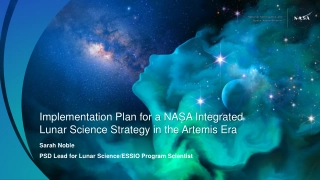
![get⚡[PDF]❤ Building Habitats on the Moon: Engineering Approaches to Lunar Settle](/thumb/21624/get-pdf-building-habitats-on-the-moon-engineering-approaches-to-lunar-settle.jpg)
